Pittsburgh Chess Club Championship 2013, Round 1: the art of swindling
Jan 16, 2013 · 8 minute read · CommentschessPittsburgh Chess ClubPittsburghNimzo-Indian Defense

PCC Championship 2013 round 1
Yesterday was the first round in the annual Pittsburgh Chess Club Championship, and I am playing in it for the first time in two years. I mentioned earlier that I have won the PCC Champion title twice, in 2006 and 2007.
Special prizes
I’m excited that this year the format has been augmented with some special prizes:
- Best Attack
- Best Defense
- Biggest Upset
All players have been invited to submit their game scores for consideration for these prizes.
Well, I’m not submitting my game score from round 1! Although I won my game, bit was a result of a swindle in which I lured my opponent into walking into danger in an otherwise drawish endgame, after which he suddenly completely fell apart.
Of course, most chess games played by humans are “ugly” like this in some way (and I have written posts about how I have been on the receiving end of swindles), so we have to embrace this reality; most games also have their cute moments. I think my game is worth looking at for the swindle that worked.
The complete annotated game
At your convenience, you can enjoy playing over the game with my annotations, including diagrams.
Preparation
This being the first round, I had no idea who my opponent would be, so had nothing to prepare.
Also, I hadn’t played a single game of chess in an entire month, so I expected to be a bit rusty. My goal was to maintain some kind of advantage, while avoiding plain losing for no reason. In the past, I have sometimes forgotten to avoid losing!
This year’s tournament
The tournament has a great turnout, and Mike Holsinger, the director, noted that it is possible that we have one of the strongest fields in the history of this tournament. There are quite a few rated Experts other than me. I look forward to facing strong competition.
Overview of my game
I was paired against Mike Kostyak, rated nearly 500 rating points below me at 1733. Ratings are deceptive though: I’ve had plenty of trouble, sometimes, winning against opponents much lower rated than me. This game was no exception.
At the board, I only recalled that I had played a couple of tournament games with Mike several years ago, when he was White, but never Black, and we have played some blitz also, but I had no memory of what openings he played as Black.
The opening
As I did in my last-played tournament game as White, I deliberately invited the Nimzo-Indian Defense. I like the challenge of “winning” the two Bishops and trying to make something out of them.
Other than my bafflingly messing up a move order that could have been punished, we arrived at a thematic position out of the opening in which I had the advantage of the two Bishops as well as more space. I considered this a large advantage, but Black’s position is solid and not the easiest to penetrate.
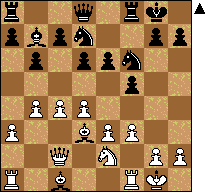
Nimzo
The middlegame
I began missing the most promising continuations during the middlegame, but still retained an advantage.
Things got complicated after Mike found a nice move to break up my Queen side Pawn structure and activate his Knight with a5:
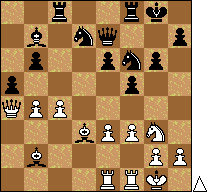
Nice tactic by Black
Inexplicably, he decided to actually sacrifice the a Pawn rather than regain it, and I was of course happy to get an extra Pawn. Nevertheless, I started making very strange passive moves, and even panicked and make a weakening move f4 that I knew would considerably reduce winning chances for me, because of giving up control over the e4 square. Re2 would have retained a large advantage instead:

White faltered with f4
The endgame
Luckily, Mike chose, instead of keeping the pressure on my position, to offer a trade of Queens.
I was ecstatic to take off the Queens.
Once the Queens were off, I felt safe in having a small advantage, being a Pawn up in the endgame. Also, here is a secret of practical chess: the stronger player usually benefits from going into an advantageous endgame. You see this at all levels: a stronger player often wins a supposedly drawn endgame; this happens whether at the level of Grandmasters beating Masters, Masters beating Experts, or Class A players beating Class C players. So usually it is not beneficial for a weaker player to deliberately go into a disadvantageous ending, unless that player is stronger at the endgame than at other phases of the game.
However, from my perspective as the stronger player, it was clear that the way things were going, a draw was not only objectively the correct result, but also very probable. If I played the “best” moves, I would only force my opponent to play obvious responses that lead to a draw. So I needed a way to encourage my opponent to play strange moves. This is how human chess differs completely from computer chess.
A sacrifice
I decided to deliberately sacrifice a Pawn in order to gain enough time to activate some of my pieces. I entered an entire line with the purpose of trying to sacrifice my g3 Pawn. Mike followed the line I wanted him to play:

g3 Pawn sacrifice
Instead of protecting the Pawn, I gave it up deliberately.
There were two dangers in this swindling attempt:
- He did not have to take the Pawn, and in fact, it was easy to draw by refusing to take it and playing a more active move instead.
- Even after taking the Pawn, he could still hold the new position, and I could have lost the Pawn for “nothing”.
But in reality, since I accepted that a draw was possible and OK, losing the Pawn while not ending up in a worse position was OK. The problem in swindling is if you sacrifice material and end up in a worse position and risk losing. There was no risk in losing in this case.
Also, I hate to say it given my love for the aspect of chess that is purely logical, but it is sensible, when playing someone you know, and who is weaker than you, that you may be able to predict, from human psychology, what will happen, and therefore playing a speculative move may be the “correct” thing to do in order to preserve winning chances. I was so sure that my opponent would take the sacrificed Pawn that it seemed like I had to go that route.
Blunders
We reached a position I aimed at all along:
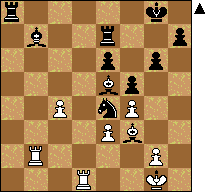
After sacrifice
At the cost of a Pawn, I managed to fully activate all of my pieces. My Rooks are ready for action, and my dark Bishop is optimally placed, and has forced Black’s Rook into passivity on e7. Objectively, Black should still be able to draw, but this kind of position is very different from the kind of position that would exist if I had not sacrificed the g3 Pawn.
Black immediately blundered horribly, and we reached this position, which is winning for White, who can fork the Rook and Knight with Bd6:
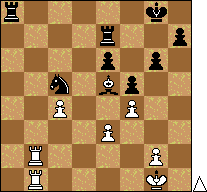
White winning
Unfortunately, I was in a state of annoyance at this point, because in his previous move, Nxb7, the losing move before Nc5, Mike had offered a draw!! That distracted me, I got confused, played quickly, and made an elementary error here, Rb8+, which should have allowed a draw again, but Mike did not see the error, and we reached a different critical position:

White might win
Reassessment
At this point a bunch of spectators had gathered, and Mike was sighing, because we all saw Bd6, of course. But I suspected (correctly) that I had been overexcited in the past couple of moves, and wanted to calm down in order to make sure that it was the winning move. I spent a lot of time (since I was way ahead on the clock anyway) just calming down. Then I saw clearly that Bd6 would not win, because Black has Rb7.
I was upset that I had missed a win, but at the same time, I still had a very good chance of winning, because Black will lose the h7 Pawn. The resulting ending is probably hard for Black to defend. So I calmly played Rh8.
Then Mike blundered for the final time, trying to save the h7 Pawn rather than saving his Knight from being forked.
Some spectators afterwards thought Mike should have played Ne4 to save the Knight, but actually, it loses quickly, because of c5, after which the Pawn is taboo because of the fork, but will advance to Queen if Black does not take it:
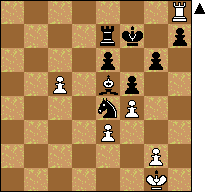
White may Queen
The final position of our game:
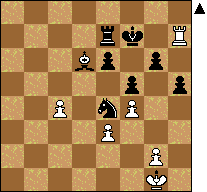
Final position
Lessons to take away from the game
- When your opponent’s position is passive, do not relieve the pressure by offering piece trades unnecessarily.
- A stronger player has more to gain by entering into an advantageous (even if objectively drawable) ending.
- Sometimes it makes sense to try a swindle, if the risk is low and psychology begs for it.
- Do not be startled and annoyed by an opponent’s offer of a draw breaking the silence after over three hours.
- Do not get overexcited when seeing a win. Double check before moving.
What next?
Next week for round 2, I am Black against Melih Ozbek, whom I’ve played once before, two years ago, when I was the one who was White. He is rated 1947, less than 200 points below me, so I’d better be less rusty than I was last night. I have no clue what openings he plays as White, so I’ll enjoy having to be completely spontaneous next week.
Conclusion
I had a tough game in round 1, in which my lower-rated opponent, despite having a worse position out of the opponent, put up counterplay that threw me off guard, and then forced me into an endgame that was objectively drawable. But I swindled him and won.